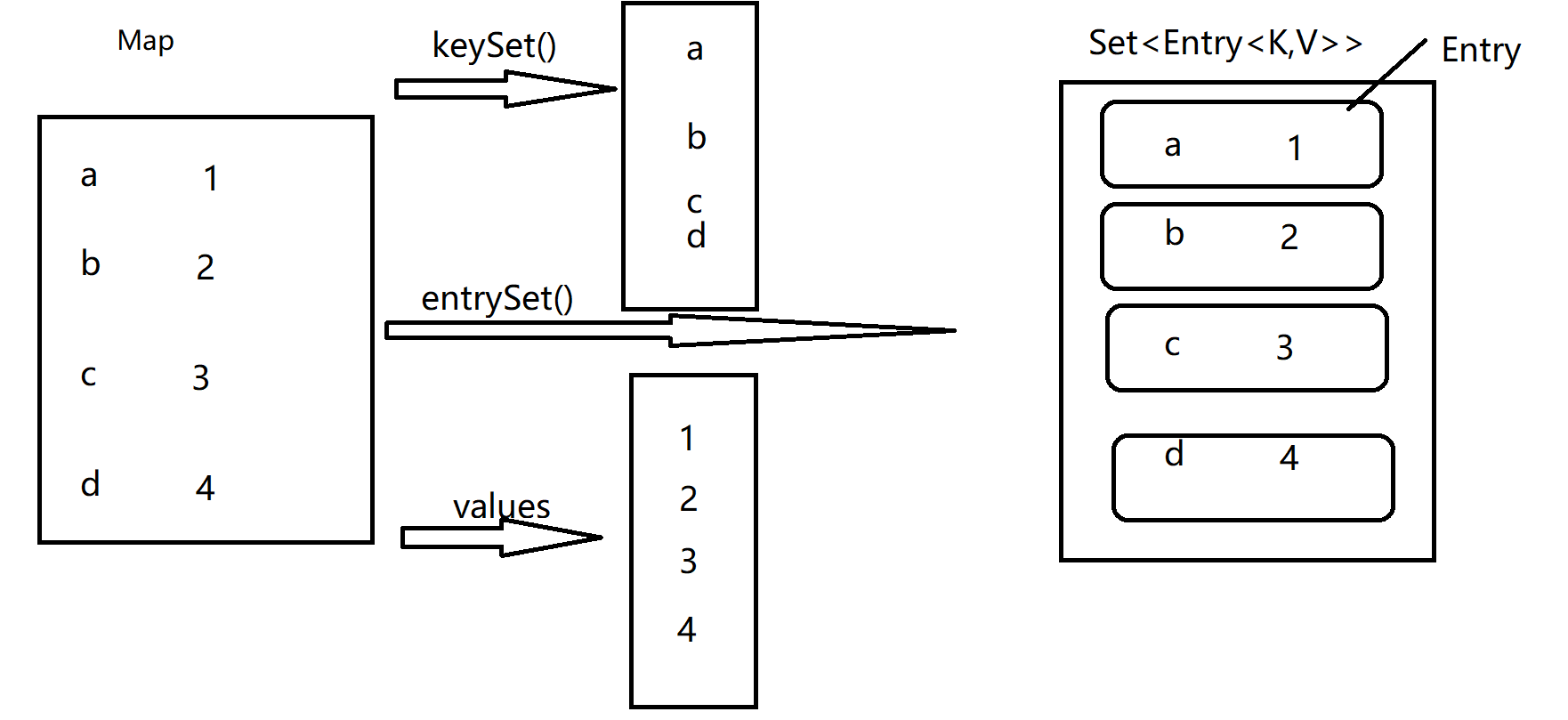零、 复习昨日
HashSet 不允许重复元素,无序
HashSet去重原理:
- 先比较hashcode,如果hashcode不一致,直接存储
- 如果hashcode值一样,再比较equals
- 如果equals值为true,则认为完全一样,不存储即去重
- 否则存储
如果使用的是空参构造创建出的TreeSet集合,那么它底层使用的就是自然排序,即放入TreeSet的元素都必须实现Comparable接口,重写方法compareTo
一、作业
public static void main(String[] args) {
String[] arr = {"a","b","c","a","b","c"};
String[] strArr = setArray(arr);
System.out.println(Arrays.toString(strArr ) );
}
// 第一题
// 设计方法,将传入的数组去重后返回
// 例如: 字符串数组:[“aa”,”bb”,”cc”,”aa”,”cc”,”bb”],将其去重变为[“aa”,”bb”,”cc”]
public static String[] setArray(String[] arr) {
// 遍历数组,取出一个,向set集合放一个,最后再变回数组
HashSet<String> set = new HashSet<>( );
for (String s : arr) {
set.add(s);
}
String[] strArr = new String[set.size()];
// 集合转数组
String[] result = set.toArray(strArr);
return result;
}
注意: T[] toArray(T[] arr)
4 创建一个Teacher类 属性age name salary
创建10个Teacher对象 装入TreeSet中
通过设置Teacher类 保证age大的在Treeset前面
age相同
salary小的在Treeset前面
salary相同 name长度小的在Treeset前面
package com.qf.homework;
/**
* --- 天道酬勤 ---
*
* @author QiuShiju
* @desc
*/
public class Teacher implements Comparable<Teacher>{
private int age;
private String name;
private double salary;
// 省略部分代码...
@Override
public int compareTo(Teacher o) {
// 如果年龄相同,则继续判断
if(o.getAge() - this.age == 0){
// 再判断工资,如果工资相同,则继续判断
if (this.salary - o.getSalary() == 0) {
// 判断名字长度,如果名字长度一致,要保留该人名,所以不能返回0,随意返回一个1或者-1
// 如果名字长度不一致,名字短的在前
return this.name.length() - o.getName().length() == 0 ? 1 : this.name.length() - o.getName().length();
} else {
// 如果工资不同,工资低的在前
return this.salary - o.getSalary() > 0 ? 1 : -1;
}
} else {
// 如果年龄不同,年龄大在前
return o.getAge() - this.age;
}
}
}
public static void main(String[] args) {
TreeSet<Teacher> treeSet = new TreeSet<>( );
treeSet.add(new Teacher(18,"老邢",50000));
treeSet.add(new Teacher(21,"老邢",50000));
treeSet.add(new Teacher(19,"小老邢",40000));
treeSet.add(new Teacher(19,"老邢",40000));
for (Teacher teacher : treeSet) {
System.out.println(teacher );
}
}
二、比较器排序
TreeSet是会对元素进行排序去重,有两种实现方案
- 使用空参构造方法创建出的TreeSet,底层使用自然排序,即元素要实现Comparable接口才能实现排序
- 第二种方案: 可以使用有参构造,在创建TreeSet集合时,传入一个
Comparator比较器,这样存入的元素就会按照该比较器指定的排序方案排序( 不再使用默认的自然排序)
TreeSet(Comparator comparator)构造一个新的空 TreeSet,它根据指定比较器进行排序。
使用步骤
- 自定义类实现Comparator 接口
- 重写compar(T o1,T o2)方法
- o1 就是之前compareTo方法中的this,即正在存储的元素
- o2 就是之前compareTo方法中的o,即以前存储过的元素
- 方法返回值与之前compareTo方法的返回值一样
- 返回0 去重
- 返回负数放左边
- 返回正数放右边
- 在创建TreeSet时,创建该比较器对象,传入TreeSet的构造方法
练习: 把昨天的排序练习使用比较器排序再写一遍
学生语数外总成绩排序题目改写
// 学生成绩类
public class StudentScore{
private String name;
private int chinese;
private int math;
private int english;
// set get...
// 有参 无参构造
}
// 自定义成绩比较器
public class MyScoreComparator implements Comparator<StudentScore> {
@Override
public int compare(StudentScore o1, StudentScore o2) {
return o2.getTotal() - o1.getTotal() == 0 ? 1 : o2.getTotal() - o1.getTotal();
}
}
public static void main(String[] args) {
// 创建集合时指定成绩比较器
TreeSet<StudentScore> set2 = new TreeSet<>(new MyScoreComparator() );
set2.add(new StudentScore("zhang3",70,70,70 ));
set2.add(new StudentScore("wang5",100,100,100 ));
set2.add(new StudentScore("li4",80,80,80 ));
set2.add(new StudentScore("zhao6",60,60,60 ));
set2.add(new StudentScore("zhou7",90,90,90 ));
for (StudentScore score : set2) {
System.out.println(score );
}
}
三、Collections
类似于与Arrays,Collections是集合的工具类,方法都是静态的
- Collections.reverse(List<?> list) 反转
- Collections.shuffle(List<?> list) 混洗
- Collections.sort(List<?> list) 排序
public static void main(String[] args) {
ArrayList<Integer> list = new ArrayList<>( );
list.add(3);
list.add(2);
list.add(5);
list.add(4);
list.add(1);
System.out.println(list );
// 反转
// Collections.reverse(list);
//System.out.println(list );
// 混洗
//Collections.shuffle(list);
// 排序,升序
Collections.sort(list);
System.out.println(list );
}
四、Map<K,V>
Map代表
双列集合,一次存储一对键值对(K,V)
Map是接口,代表是键映射到值的对象,一个Map不能包含重复的键,值允许重复.每个键最多只能映射到一个值,即可以通过键找到值,但是不能通过值找键.
方法都是非常常见的方法,但是Map是接口无法演示
Map有两个常用实现类
- HashMap
- TreeMap
五、HashMap
HashMap是Map的实现类,现在JDK8及以后底层是由数组+链表+红黑树实现
并允许使用null值和null键HashMap存储的元素是
不保证迭代顺序,存储的键不允许重复,值允许重复
除了非同步和允许使用 null 之外,
HashMap类与Hashtable大致相同
补充: Hashtable是线程安全的map集合,效率低 ; HashMap是线程不安全的,效率高
ConcurrentHashMap 即安全又高效的Map集合
HashMap的容量和扩容: 初始容量16,加载因子0.75 阈值是 16 * 0.75,达到阈值扩容至原来的2倍
ps: 昨天学习的HashSet所有特性,其实就是HashMap的特性,包括去重原理
5.1 方法演示
构造方法
HashMap()
构造一个具有默认初始容量 (16) 和默认加载因子 (0.75) 的空 HashMap。
HashMap(int initialCapacity)
构造一个带指定初始容量和默认加载因子 (0.75) 的空 HashMap。
HashMap(int initialCapacity, float loadFactor)
构造一个带指定初始容量和加载因子的空 HashMap。
HashMap(Map<? extends K,? extends V> m)
构造一个映射关系与指定 Map 相同的新 HashMap。
方法
每个都很重要!!!
public static void main(String[] args) {
// 创建空的HashMap;
HashMap<String,Integer> map = new HashMap<>();
System.out.println(map );
// 添加元素,一次添加一对,键值
// put方法的返回值,如果该键之前没有映射值,返回null
// 如果该键之前映射的有值,则将值覆盖,返回上次的旧值
Integer v1 = map.put("a",1);
System.out.println(v1 );
Integer v2 = map.put("a", 2);
System.out.println(v2 );
Integer v3 = map.put("d", 4);
System.out.println(v3 );
map.put("b",2);
System.out.println(map );
// 取出元素
// 通过键返回值
Integer v = map.get("a");
System.out.println(v );
// 集合大小(元素个数)
System.out.println(map.size() );
// 集合是否为空
System.out.println(map.isEmpty() );
// 清空集合
//map.clear();
// 集合大小(元素个数)
//System.out.println(map.size() );
// 集合是否为空
//System.out.println(map.isEmpty() );
// 移除元素,根据键移除整个键值对,返回值
Integer a = map.remove("a");
System.out.println(a );
System.out.println(map );
/**
* boolean containsKey(Object key)
* 判断集合中是否包含指定键,有则返回 true。
* boolean containsValue(Object value)
* 判断集合中是否包含指定值,有则返回 true。
*/
System.out.println(map.containsKey("A"));
System.out.println(map.containsValue(11));
}
5.2 迭代/遍历
Map接口提供三种collection 视图,允许以键集、值集或键-值映射关系集的形式查看某个映射的内容
- Set keySet() 键集,返回一个Set集合,其中只有键
- Collection values() 值集,返回一个Collection集合,其中只有值
- Set<Map.Entry<K,V>> entrySet() 键值映射集,返回一个Set集合,其中放着key-value对象
5.2.1 键集
public static void main(String[] args) {
HashMap<String,Integer> map = new HashMap<>();
map.put("a",1);
map.put("b",2);
map.put("c",3);
map.put("d",4);
// 键集遍历
Set<String> keySet = map.keySet();
// 获得迭代器
Iterator<String> iterator = keySet.iterator( );
while (iterator.hasNext()) {
System.out.println(iterator.next());
}
System.out.println("-----------" );
for(String key : keySet) {
System.out.println(key );
}
}
5.2.2 值集
// 值集
Collection<Integer> values = map.values();
Iterator<Integer> iterator1 = values.iterator( );
while (iterator1.hasNext( )) {
System.out.println(iterator1.next());
}
System.out.println("-----------" );
for (Integer value : values) {
System.out.println(value );
}
5.2.3 键值映射集 [非常重要]
Entry是Map接口中的内部接口,代表是一个键值对,即包含键和值.
且该Entry接口中提供了关于操作单个键,值的方法
- K getKey()
- V getValue()
// 获得键值映射集合Set,其中放着Entry
Set<Entry<String,Integer>> entrySet = map.entrySet();
Iterator<Entry<String,Integer>> iterator2 = entrySet.iterator();
while (iterator2.hasNext( )) {
// 从迭代器取出的是Entry
Map.Entry<String,Integer> entry = iterator2.next();
// 通过entry可以单独获得键,值
String key = entry.getKey( );
Integer value = entry.getValue( );
System.out.println(key +"-->" + value );
}
// for循环
for(Map.Entry<String,Integer> entry : entrySet) {
System.out.println(entry.getKey() +"--->" +entry.getValue() );
}

5.3 去重原理
HashMap的去重其实就是昨天讲的HashSet的去重,因为HashSet底层就是HashMap
在创建HashSet时,其实在底层创建了HashMap

在向set中添加元素时,其实是向map的key上添加

所以HashMap的
键的去重原理就是
- 向键存储数据时,先调用键的hashcode()方法
- 如果hashcode值不一样则直接存储
- 如果hashcode值一样,再调用元素的equals()方法
- 如果equals方法返回false,则存储
- 如果equals方法返回true,则不存储
5.4 HashMap的应用
场景一: 适合有关联映射的场景
设计方法,传入字符串,输出该字符串中每个字符出现的次数,使用HashMap实现
例如: “abcHelloabcWorld”,输出 a出现2次,b出现2次,l出现3次,H出现1次
/**
* 倒推: a --> 3 b --> 2
* @param str
*/
public static void cishu(String str) {
String[] strArr = str.split("");
System.out.println(Arrays.toString( strArr) );
HashMap<String, Integer> map = new HashMap<>( );
for (int i = 0; i < strArr.length; i++) {
String s = strArr[i];
if (!map.containsKey(s)) {
map.put(s,1);
} else {
Integer count = map.get(s);
count++;
map.put(s,count);
}
}
// System.out.println(map );
Set<Map.Entry<String, Integer>> entrySet = map.entrySet( );
for (Map.Entry<String,Integer> entry :entrySet) {
String s = entry.getKey( );
Integer count = entry.getValue( );
System.out.println("字符"+s+",出现"+count+"次" );
}
}
场景二: Map可以当实体类对象
public class Student{
private int age;
private String name;
// ...
}
Student s1 = new Student(18,"zs");
s1.getAge();
s1.getName();
使用Map模拟对象
HashMap<String, Object> stu = new HashMap<>( );
stu.put("age",18);
stu.put("name","zs");
stu.put("sex","男");
LinkedHashMap: …
六、TreeMap
TreeMap底层是红黑树(平衡二叉树的一种)
同样式存储键值对,键不允许重复且还会排序
默认是根据键元素的自然顺序排序或者,根据创建TreeMap时指定的Comparator比较器来排序
6.1 方法演示
方法详见api
public static void main(String[] args) {
TreeMap<String, Integer> map = new TreeMap<>( );
map.put("b",2);
map.put("e",5);
map.put("a",1);
map.put("a",2);
map.put("d",4);
map.put("c",3);
// 其他正常的map方法...
// 三个遍历方法...
// 特殊的,有关于头尾操作的方法
// 获得排序后的第一个
String key = map.firstKey( );
// 获得排序后的第一个Entry
Map.Entry<String, Integer> entry = map.firstEntry( );
System.out.println(entry );
}
6.2 TreeMap排序去重原理
昨天学习的TreeSet的底层其实就是TreeMap
创建TreeSet时,创建TreeMap

向set集合添加元素时,其实是向TreeMap的键添加元素

即TreeMap的排序去重原理是什么?其实如果自然排序就是compareTo(),如果是比较器排序就是compar()方法
- 方法返回0 去重
- 方法返回负数 放在树左侧
- 方法返回正数 放在树的右侧
七、总结
集合体系中最重要最常见的两个集合是ArrayList,HashMap
其他的,
- 记住常用的API(crud和遍历)
- 记住List和Set区别
- 记住ArrayList和LinkedList区别
- 记住HashMap扩容,去重原理
- 记住TreeMap的排序去重原理























 414
414











 被折叠的 条评论
为什么被折叠?
被折叠的 条评论
为什么被折叠?










